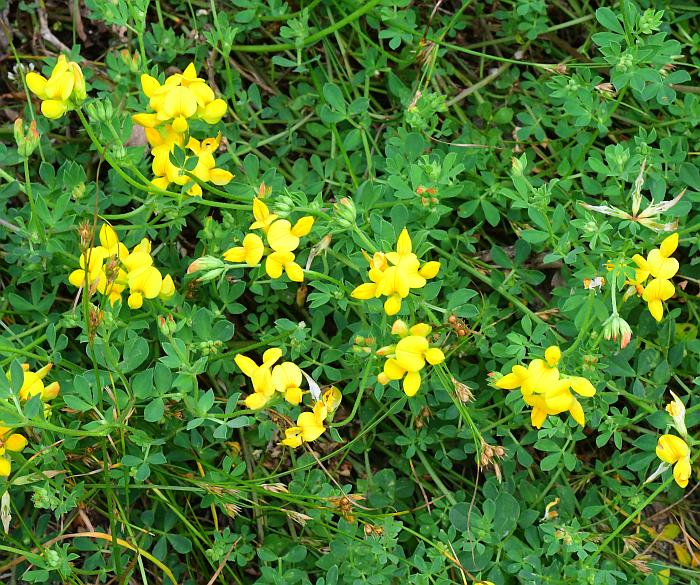Lotus corniculatus L.
Bird's Foot Trefoil

Introduced
CC = *
CW = 3
MOC = 45
© SRTurner
Lotus corniculatus L.Bird's Foot Trefoil | |
 |
Introduced CC = * CW = 3 MOC = 45 |
© SRTurner |
|
Family - Fabaceae/Faboideae Habit - Perennial forb, from a woody taproot, sometimes with rhizomes. Stems - Spreading to ascending, to 60 cm, branched, often forming loose mounds, angled, unarmed, glabrous or sparsely to moderately pubescent with appressed-ascending hairs, especially toward the tip.
Leaves - Alternate, compound with 5 leaflets, sessile. Stipules inconspicuous, minute glandlike dots. Leaflets 4-20 mm long, 2.5-5.0 mm wide, the basal pair lanceolate or more commonly asymmetrically ovate to broadly ovate (the upper margin angled at the base, the lower margin rounded to somewhat auriculate and clasping the stem), the upper lateral pair and terminal leaflet symmetrically oblong-oblanceolate to obovate, the margins entire, glabrous or sparsely hairy, the surfaces glabrous or sparsely hairy, angled or slightly tapered to a sessile base, angled or tapered to a sharply pointed tip, rarely rounded.
Inflorescences - Axillary, umbellate to loosely headlike clusters of 3-8 flowers, the stalk 2-10 cm long, with fine appressed-ascending hairs or nearly glabrous, with a simple, leaflike bract and a pair of minute glands at the tip, the flower with a stalk 0.7-1.5 mm long above the bract. Bractlets absent.
Flowers - Calyces sparsely hairy, the tube 2-3 mm long, the lobes 2-3 mm long, more or less similar, linear to narrowly lanceolate. Corollas papilionaceous, bright yellow, sometimes with the main nerves red toward the base, often turning orange or becoming marked with brownish red with age, the banner 11-16 mm long, 6-8 mm wide, broadly ovate to nearly circular, the wings 10-14 mm long, 3-4 mm wide, oblong, the keel 11-14 mm long, 3-4 mm wide, boat-shaped, fused to above the midpoint, abruptly curved upward near the midpoint, narrowed toward the tip. Stamens 10, of 2 lengths (alternating longer and shorter filaments), 9 of the filaments fused and 1 usually shorter filament free, the fused portion 6-7 mm long, the free portion 2-4 mm long, those of at least the longer stamens flattened and broadened at the tip, the anthers relatively small, attached near the base. Ovary 5-6 mm long, the style 4-6 mm long, slender, curved upward abruptly at the base, hairy at the tip, the stigma small and terminal.
Fruits - Legumes, 1.5-3.0 cm long, 1.5-2.5 mm wide, narrowly oblong to linear, beaked, not circular in cross-section, the sutures not thickened, dehiscing by 2 valves, these green to reddish brown at maturity, twisting spirally after dehiscence, mostly 5-14-seeded. Seeds 1.2-1.5 mm long, 0.9-1.2 mm wide, broadly kidney-shaped in outline, the surface olive green to reddish brown, often mottled with darker brown or black, smooth, somewhat shiny.
Flowering - May - September. Habitat - Fields, pastures, roadsides, railroads, upland prairies, streambanks. Origin - Native to Europe but introduced on nearly every continent. Lookalikes - None close. Other info. - This species is becoming quite widespread in Missouri, having been widely planted in the past for soil stabilization in connection with road projects. It has been cultivated for cattle fodder because it does well in very poor soils and has a high protein content. The plant is easily recognized by its umbels of small but showy, bright yellow flowers. The leaves are unusual, having a form which most botanists would label as trifoliate with large stipules. In reality, the leaves are probably instead pinnately compound with five leaflets. Photographs taken off River Rd., Platte County, MO., 6-11-00, and off Hwy 13 near Springfield, MO., 7-5-03 (DETenaglia); also along the Katy Trail near Dutzow, Warren County, MO, 7-1-2020, near Allenton, St. Louis County, MO, 7-29-2020, and at Glassberg Conservation Area, Jefferson County, MO, 6-26-2023 (SRTurner). |